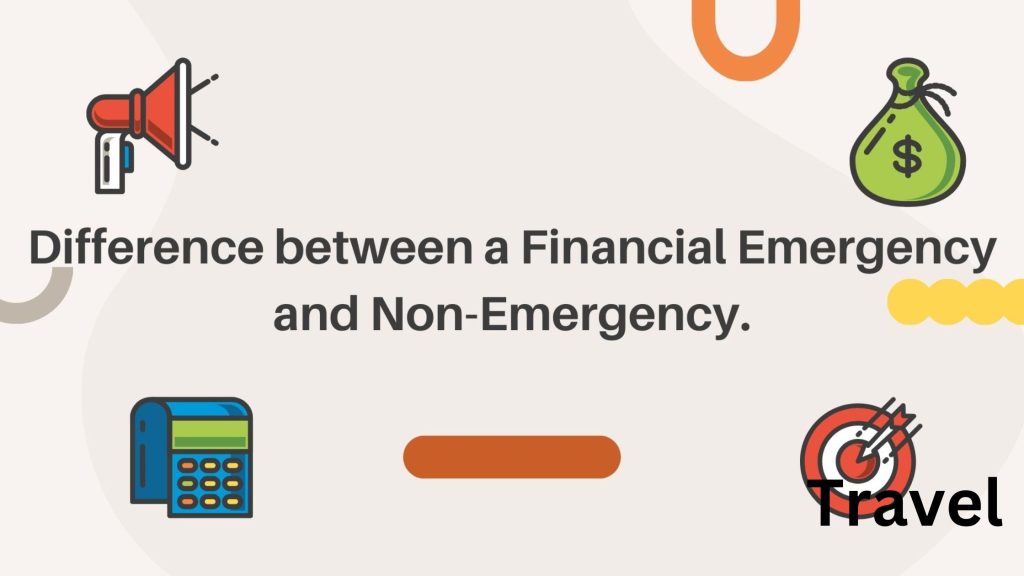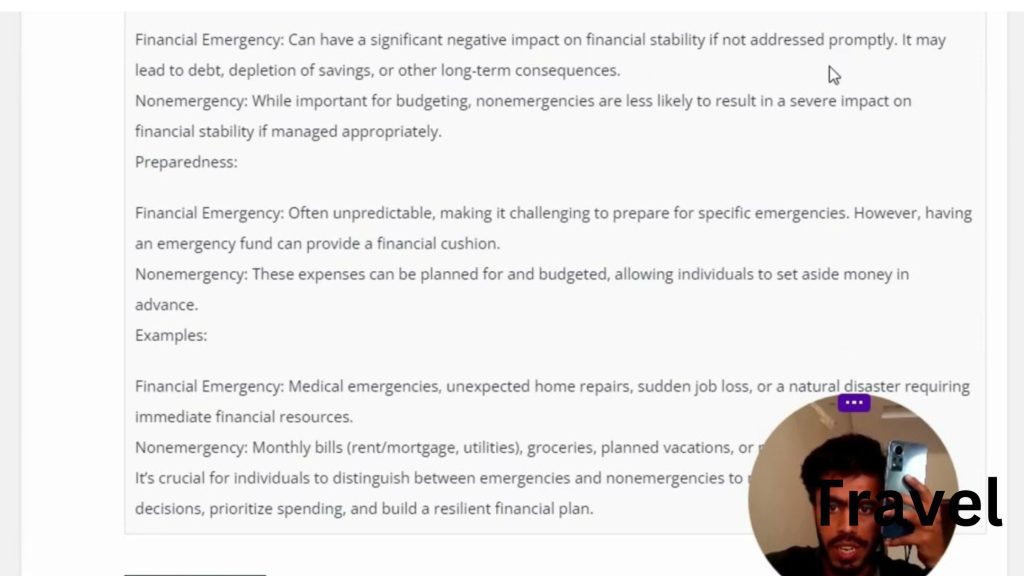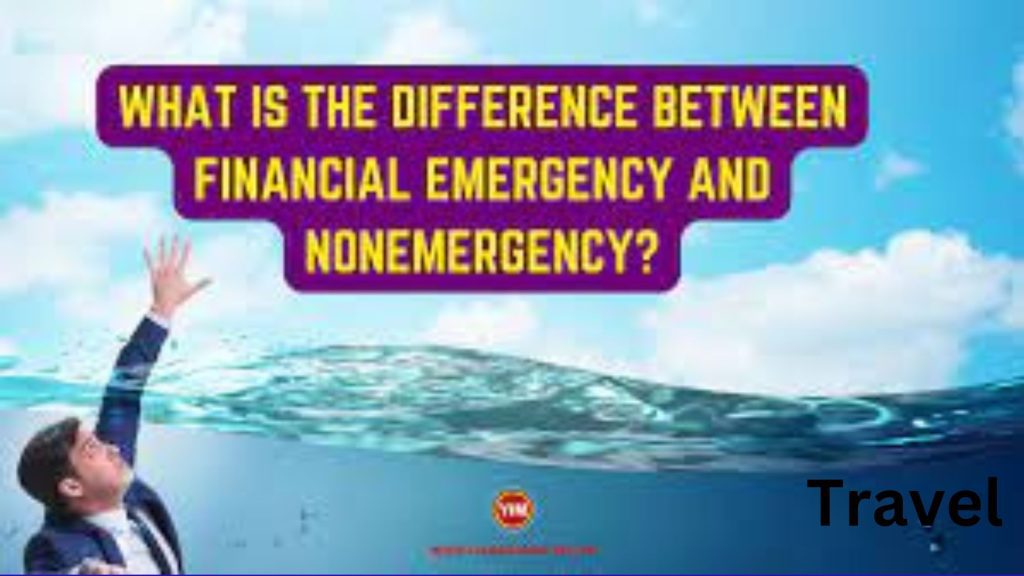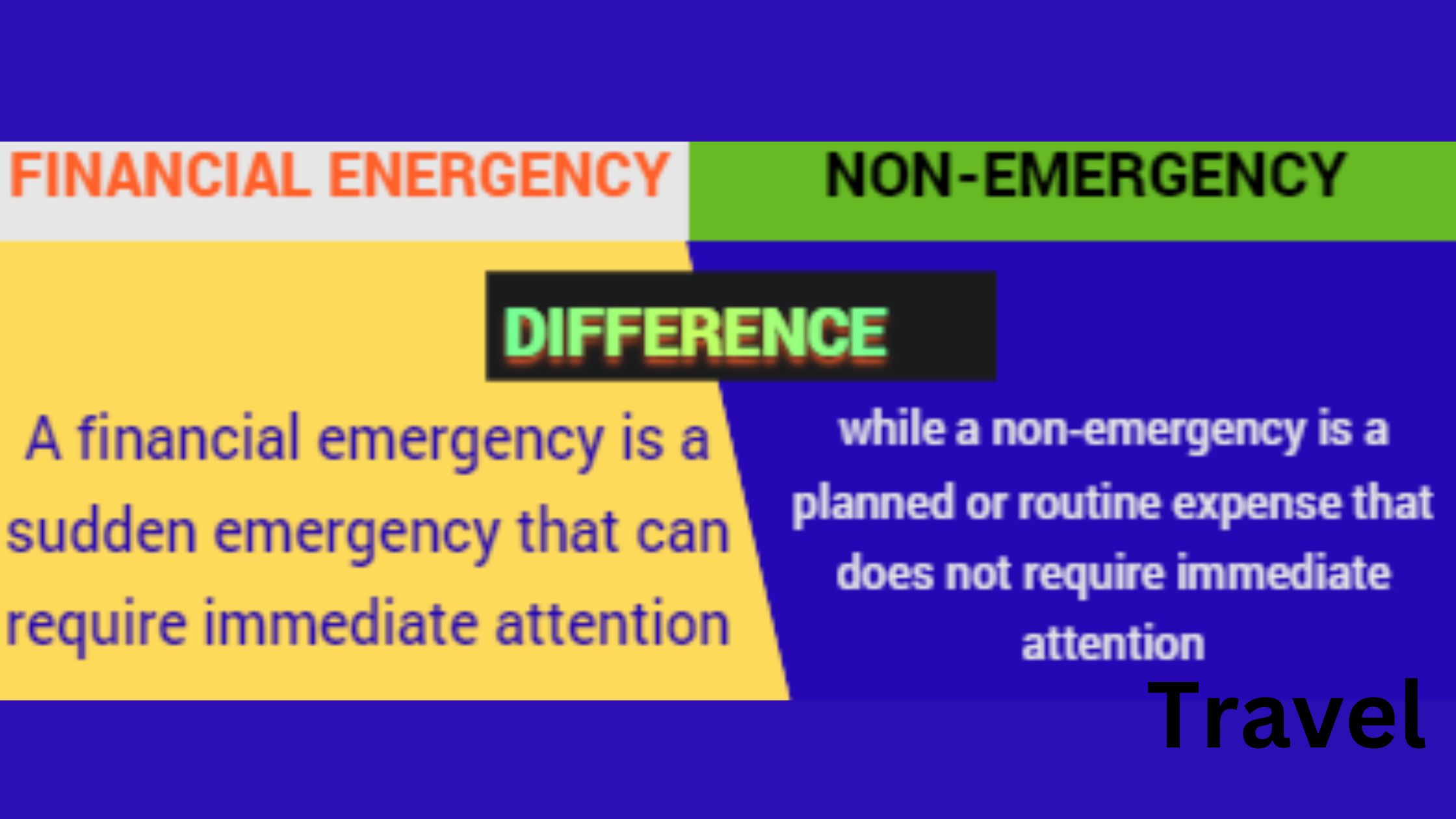“Contrast the Difference between a Financial Emergency And a Nonemergency with our comprehensive guide. Learn to differentiate between urgent situations and regular expenses, empowering yourself to make informed financial decisions and secure your future.”
Understanding the contrast between a financial emergency and a nonemergency is critical in effective personal finance management. A financial emergency is a sudden, unforeseen event that demands quick monetary action, such as a medical crisis or job loss.
Such situations often lead to the depletion of savings or the need for emergency loans. On the other hand, nonemergencies involve foreseeable costs like routine car maintenance or holiday expenses, which can be anticipated and budgeted for in advance. Recognizing these distinctions helps prioritize financial goals, set aside an emergency fund, and plan for future expenditures accordingly. Quick and informed responses to financial emergencies can prevent a ripple effect of economic strain, whereas proper anticipation of nonemergencies ensures steady financial health.
Financial Emergencies Explained
Imagine a sudden, critical expense that pops up from nowhere. That’s a financial emergency. It’s a big deal because it means unexpected money problems that need quick solutions. We’re talking about expenses that, if handled slowly, could rattle your financial security.
Characteristics Of A Contrast the Difference between a Financial Emergency And a Nonemergency
Financial emergencies strike without warning. These events have several key features-
- Urgency- This must be dealt with promptly.
- Importance- Essential expenses that cannot be ignored.
- Unpredictability- Typically occurs without notice.
- Cost- Usually requires a substantial amount of money.
Common Types Of Financial Emergencies
What counts as a financial emergency, you ask? Here’s a list to guide you-
Type of Emergency Description
Medical Expenses Unplanned medical bills or crisis.
Home Repairs Important and unexpected fixes at home.
Job Loss Income stops suddenly due to unemployment.
Car Troubles Essential vehicle repairs needed out of the blue.
Natural Catastrophes are caused by calamities like earthquakes and floods.
Nonemergency Financial Situations

Understanding your financial landscape requires knowing which expenses can wait and which cannot. Nonemergency financial situations are those events or costs that, while important, do not require immediate payment. Recognizing and planning for these can ensure economic stability and prevent unnecessary stress.
How can an emergency fund reduce stress?
An emergency fund can significantly reduce stress by providing a financial safety net during unexpected situations. Knowing that money is set aside expressly for emergencies such as medical expenses, car repairs, or sudden job loss can bring a sense of security and peace of mind.
Rather than feeling overwhelmed or panicked when faced with unforeseen expenses, individuals with an emergency fund can approach these situations with greater confidence and stability, knowing they can address the issue without resorting to high-interest loans or draining their savings for other purposes.
Distinguishing Nonemergency Expenses
Nonemergency expenses often differ in urgency and importance. They are not immediate threats to your financial health. Instead, they are predictable costs that you can prepare for over time. Some examples include-
- Annual subscriptions like software licenses or memberships
- Regular maintenance costs for vehicles or home appliances
- Planned vacations or gift purchases for holidays
- Upcoming educational expenses like tuition or textbooks
Planning For Nonurgent Financial Needs
To manage nonurgent financial needs, create a budget that accounts for them. This involves:
- Identifying all nonemergency expenses
- Estimating their costs
- Allocating funds in a dedicated savings account
- Reviewing and adjusting plans as required
Sample Budget Allocation for Nonurgent Needs Expense Category Estimated Cost Monthly Savings Goal
Vacation Fund $2,000 $166.67
Education Fund $1,000 $83.33
Gift Fund $500 $41.67
Car Maintenance $750 $62.50
By distinguishing and planning for nonemergency expenses, future financial challenges become manageable. This approach ensures you avoid dipping into emergency funds for predictable costs and maintain a solid financial footing.
Key Differences
Recognizing the distinction between a financial emergency and a nonemergency is critical. Let’s explore how urgency, response time, and funding sources differ.
Urgency And Impact
Financial emergencies demand immediate action. They pose severe, swift impacts if not addressed. Nonemergencies allow for more planning and less immediate stress.
A lost job or medical crisis exemplifies an emergency. On the other hand, saving for a vacation is a non-emergency.
Time Frame For Response
Quick response within days or hours is often required for emergencies. Nonemergencies involve goals set for the future, providing ample time to prepare.
Emergency- Repair a broken furnace in winter. Nonemergency- Replace an outdated kitchen appliance.
Sources Of Funds
- Emergency funds are ideally earmarked for crises.
- Savings or investment income can fund nonurgent needs over time.
Credit cards or loans might be necessary for unexpected costs. Planned purchases can be budgeted.
Case Studies
Understanding financial priorities can be challenging. Case studies help us see the difference between emergencies and nonemergencies. Let’s dive into two examples demonstrating this.
Case Study- Medical Bills
Imagine Jane breaks her leg. She rushes to the hospital. Doctors say surgery is needed. The bills go high. Jane has no insurance. This is a financial emergency.
- Immediate medical attention needed
- High unexpected costs
- Health at risk without treatment
Saving lives and health comes first. Jane’s situation is critical. The cost is secondary. Jane’s friends do a fundraiser. The community helps with donations. Jane gets her treatment.
Case Study- Upgrading A Car
Bob has a car. It works fine but is old. He wants a new one with better features. It’s tempting but not urgent. This is a non-emergency.
Current Situation Desire
The car is functional New model with upgrades
No immediate cost Large expense for comfort
Bob plans to save money for the new car. He sets aside money each month. He waits for the right time. No rush to spend. Thoughtful planning makes a dream car a future reality.
Managing Funds For Emergencies
Managing Funds for Emergencies requires understanding the nuances between urgent financial needs and those that can wait. It’s about being prepared for situations that demand immediate financial attention versus those that are less pressing. Planning can mean distinguishing between a manageable situation and an economic crisis.
Building An Emergency Fund
An Emergency Fund is a financial cushion designed to cover unexpected expenses. These funds ensure you’re aware of life’s surprises. Here are some tips:
- Start small- Even modest savings can make a significant impact.
- Set a goal- Target three to six months of expenses for maximum security.
- Keep it accessible- Your emergency fund should be readily available but not too easy to spend on nonemergencies.
Insurance As A Safety Net

Insurance acts as a safeguard, offering protection against unforeseen events. Think of it as a preemptive strike against potential financial emergencies. Key insurance types-
Type of Insurance Benefits
Health Insurance Covers medical bills and health-related emergencies.
Auto Insurance Protects in case of vehicle-related accidents.
Homeowner’s/Renter’s Insurance Secures your home and belongings from damage or theft.
Life Insurance Offers financial support to your loved ones in your absence.
Choosing the right insurance policies can shield you from the financial strain of unexpected events.
Handling Nonemergency Expenses
Handling Nonemergency Expenses means planning ahead. These costs do not require urgent action. Instead, they need a strategy. This plan lets you manage money without stress. Think of nonemergency expenses as future events you can prepare for, like a vacation or a new laptop. It’s about being ready so you are not caught off guard.
Financial emergency examples
Financial emergencies can strike unexpectedly, disrupting stability and causing stress. Examples include sudden medical expenses not covered by insurance, unexpected car repairs necessary for transportation to work, or job loss leading to a temporary loss of income.
Other emergencies include home repairs due to damage from natural disasters or unforeseen legal fees. These situations can quickly deplete savings and necessitate immediate action to mitigate their impact on financial well-being.
Budgeting For Large Purchases
Big buys should not be surprises. A reasonable budget turns “wants” into planned “wins.” Begin with a list of what you want. Next, track your spending for a month. See where you can cut back. Put this extra money towards your goal. Use a budgeting app or spreadsheet for this. Stay patient and persistent.
- List upcoming large purchases
- Track current spending habits
- Identify savings opportunities
- Allocate funds toward saving goals
Smart Saving Strategies
Start with small steps. Savings grow over time. If you do not already have one, open a savings account. Set up an automatic transfer each payday. Even a tiny amount will do. Look for high-interest options to grow your money faster. Consider bonds or certificates of deposits for unused cash. Always keep an emergency fund separate.
Strategy Action Benefit
Automatic transfers Set up on payday Consistent savings growth
High-interest accounts Invest extra cash Higher returns
Emergency fund Separate account Peace of mind
Psychological Aspects
Understanding financial emergencies and nonemergencies impacts our minds differently. Exploring how these situations influence stress levels and decision-making abilities is crucial. Knowing how to handle your money can also affect our responses. Let’s dive into the psychological aspects of financial pressures.
Stress And Decision Making
When money gets tight, stress kicks in. Financial emergencies can spike stress, affecting how we think and act. High stress can lead to quick and sometimes regrettable decisions. Nonemergencies, while still serious, often don’t push us to our mental limits.
- Emergencies trigger fight-or-flight responses, clouding judgment.
- Nonemergencies allow more time to weigh options and make informed choices.
Stress management is critical. It helps maintain clear thinking, even when finances falter.
The Role Of Financial Literacy
Financial literacy lightens the mental load. Knowing how to manage money can define whether an issue is an emergency. The more you know, the better you prepare.
- Basic money skills keep panic at bay during tight situations.
- Advanced knowledge can even prevent some emergencies from happening.
Learning about finances builds confidence and eases stress. It leads to better choices, regardless of the monetary challenge.
Future-proofing Your Finances
Lifespan surprises require ready money. Financial emergencies mean sudden needs like health costs or job loss. Nonemergencies are predictable expenses like retirement. A plan makes money less worrisome. Let’s ensure cash is there when needed most.
Creating A Comprehensive Financial Plan
A detailed plan is a money map. It shows where each penny should go. It guides during emergencies and calm times. This plan should cover:
- Budgeting – Tracks spending habits.
- Savings goals – Sets money aside for future needs.
- Insurance – Protects against unforeseen losses.
- Investments – Grows wealth over time.
Follow these steps to keep money safe and growing:
Step Action
1 Identify income and expenses.
2 Set short and long-term goals.
3 Create a saving and spending plan.
4 Choose the right insurance and investments.
Regular Review And Adjustment
Money plans need check-ups. Lives change, so money plans should, too. Every few months, check the plan. Make sure it fits your current life and goals.
Key steps include:
- Assess changes – Income, expenses, or family size may change.
- Update goals – New goals or priorities may emerge.
- Adjust budgets and plans – Make changes to stay on track.
Regular reviews make plans work, even when surprise expenses hit. Life is easier when money worries shrink.
Expert Opinions
Understanding the stark contrast between financial and nonemergencies is crucial in personal finance. Experts weigh in on this topic to guide us through these nuanced scenarios.
Financial Advisors On Emergency Planning
Critical voices in the industry, such as financial advisors, emphasize proactive emergency planning. They argue that an emergency is a sudden, unforeseen event that requires immediate monetary attention. A less urgent need is a non-emergency.
According to their guidance, here are essential steps to prepare:
- Save three to six months’ living expenses to start an emergency fund.
- Insurance coverage- Ensure proper coverage for health, property, and life.
- Investment liquidity- Maintain some investments that can be quickly converted to cash.
Psychologists On Financial Stress Management

On the other hand, psychologists address the mental impact of financial strain. A sudden fiscal crisis can cause stress and anxiety. This can be lessened with effective stress management strategies.
They offer these tips to manage financial stress-
- Stay informed- Knowledge reduces uncertainty and anxiety.
- Plan for contingencies- Have a concrete plan for emergencies.
- Seek support- Talk to professionals or support groups for guidance.
Frequently Asked Questions Of Contrast The Difference Between A Financial Emergency And Nonemergency.
What Defines A Financial Emergency?
A financial emergency is an unexpected expense that requires immediate attention and resources. This can include sudden medical bills, job loss, or urgent home repairs exceeding your budget and savings.
How Does A Nonemergency Differ Financially?
Financial nonemergencies are planned or predictable expenses that do not require immediate action. They include routine costs, regular maintenance, or anticipated purchases, allowing for budgeting and saving over time.
When To Use Emergency Funds?
Emergency funds should be utilized during actual financial crises. These are occasions when you’re faced with unexpected, essential costs that can’t be covered by your monthly income or regular savings.
How Much To Save For Emergencies?
Financial advisors typically recommend saving three to six months of living expenses in an accessible emergency fund. This provides a financial cushion for unforeseen events without compromising your day-to-day budget.
Conclusion
Understanding the nuances between financial emergencies and nonemergencies is crucial. Knowing which helps you prioritize spending and savings. Always have a plan for unexpected costs, and manage routine expenses wisely. This strategy ensures financial stability, helping you navigate your fiscal journey with confidence and ease.
Remember, preparedness is critical.

I am a travel specialized writer and blogger based in the USA and UK, CANADA. I have four years of experience in travel and all types of tours. So I work on solving these issues and give various tips on these issues. I handling carefully of these issues. So, I will share this information with everyone.

